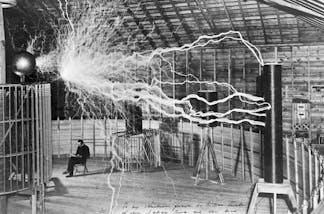
Prepare to be stunned by a technology that nature perfected. maradek/iStock via Getty Images
–
Published: 2022 May 09
–
As the world’s need for large amounts of portable energy grows at an ever-increasing pace, many innovators have sought to replace current battery technology with something better.
Italian physicist Alessandro Volta tapped into fundamental electrochemical principles when he invented the first battery in 1800. Essentially, the physical joining of two different materials, usually metals, generates a chemical reaction that results in the flow of electrons from one material to the other. That stream of electrons represents portable energy that can be harnessed to generate power.
The first materials people employed to make batteries were copper and zinc. Today’s best batteries – those that produce the highest electrical output in the smallest possible size – pair the metal lithium with one of several different metallic compounds. There have been steady improvements over the centuries, but modern batteries rely on the same strategy as that of Volta: pair together materials that can generate an electrochemical reaction and snatch the electrons that are produced.

–
But as I describe in my book “Spark: The Life of Electricity and the Electricity of Life,” even before humanmade batteries started generating electric current, electric fishes, such as the saltwater torpedo fish (Torpedo torpedo) of the Mediterranean and especially the various freshwater electric eel species of South America (order Gymnotiformes) were well known to produce electrical outputs of stunning proportions. In fact, electric fishes inspired Volta to conduct the original research that ultimately led to his battery, and today’s battery scientists still look to these electrifying animals for ideas.
Copying the eel’s electric organ
Prior to Volta’s battery, the only way for people to generate electricity was to rub various materials together, typically silk on glass, and to capture the resulting static electricity. This was neither an easy nor practical way to generate useful electrical power.
Volta knew electric fishes had an internal organ specifically devoted to generating electricity. He reasoned that if he could mimic its workings, he might be able to find a novel way to generate electricity.

–
The electric organ of a fish is composed of long stacks of cells that look very much like a roll of coins. So Volta cut out coin-like disks from sheets of various materials and started stacking them, in different sequences, to see if he could find any combination that would produce electricity. These stacking experiments kept yielding negative results until he tried pairing copper disks with zinc ones, while separating the stacked pairs with paper disks wetted with saltwater.
This sequence of copper-zinc-paper fortuitously produced electricity, and the electrical output was proportionate to the height of the stack. Volta thought he had uncovered the secret of how eels generate their electricity and that he had actually produced an artificial version of the electric organ of fish, so he initially called his discovery an “artificial electric organ.” But it was not.
What really makes eels electrifying
Scientists now know the electrochemical reactions between dissimilar materials that Volta discovered have nothing to do with the way an electric eel generates its electricity. Rather, the eel uses an approach similar to the way our nerve cells generate their electrical signals, but on a much grander scale.
Specialized cells within the eel’s electric organ pump ions across a semipermeable membrane barrier to produce an electrical charge difference between the inside versus the outside of the membrane. When microscopic gates in the membrane open, the rapid flow of ions from one side of the membrane to the other generates an electrical current. The eel is able to simultaneously open all of its membrane gates at will to generate a huge jolt of electricity, which it unleashes in a targeted fashion upon its prey.
Electric eels don’t shock their prey to death; they just electrically stun it before attacking. An eel can generate hundreds of volts of electricity (American household outlets are 110 volts), but the eel’s voltage does not push enough current (amperage), for a long enough time, to kill. Each electric pulse from an eel lasts only a couple thousandths of a second and delivers less than 1 amp. That’s just 5% of household amperage.
This is similar to how electric fences work, delivering very short pulses of high-voltage electricity, but with very low amperage. They thus shock but do not kill bears or other animal intruders that try to get through them. It is also similar to a modern Taser electroshock weapon, which works by quickly delivering an extremely high-voltage pulse (about 50,000 volts) carrying very low amperage (just a few milliamps).
Modern attempts to mimic the eel
Like Volta, some modern electrical scientists searching to transform battery technology find their inspiration in electric eels.
A team of scientists from the United States and Switzerland is currently working on a new type of battery inspired by eels. They envision that their soft and flexible battery might someday be useful for internally powering medical implants and soft robots. But the team admits they have a long way to go. “The electric organs in eels are incredibly sophisticated; they’re far better at generating power than we are,” lamented Michael Mayer, a team member from the University of Fribourg. So, the eel research continues.

–
In 2019, the Nobel Prize in Chemistry was awarded to the three scientists who developed the lithium-ion battery. In conferring the award, the Royal Swedish Academy of Sciences asserted that the awardees’ work had “laid the foundation of a wireless, fossil fuel-free society.”
The “wireless” part is definitely true, since lithium-ion batteries now power virtually all handheld wireless devices. We’ll have to wait and see about the “fossil fuel-free society” claim, because today’s lithium-ion batteries are recharged with electricity often generated by burning fossil fuels. No mention was made of the contributions of electric eels.
[Over 150,000 readers rely on The Conversation’s newsletters to understand the world. Sign up today.]
Later that same year, though, scientists from the Smithsonian Institution announced their discovery of a new South American species of electric eel; this one is notably the strongest known bioelectricity generator on Earth. Researchers recorded the electrical discharge of a single eel at 860 volts, well above that of the previous record-holding eel species, Electrophorus electricus, that clocked in at 650 volts, and 200-fold higher that the top voltage of a single lithium-ion battery (4.2 volts).
Just as we humans try to congratulate ourselves on the greatness of our latest portable energy source, the electric eels continue to humble us with theirs.
–
–
- Electricity
- Electrons
- Batteries
- Biomimicry
- Tasers
- History of science
- Eels
- Biophysics
- Battery
- Lithium-ion batteries
–
Partners

Republish our articles for free, online or in print, under a Creative Commons license.
–
Want to write?
Write an article and join a growing community of more than 146,000 academics and researchers from 4,367 institutions.












